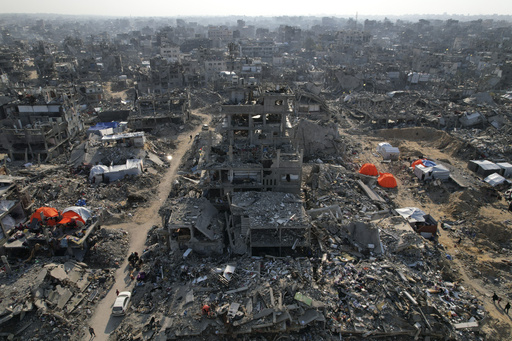JERUSALEM — The Israeli military has announced that its forces will continue to occupy five key positions in southern Lebanon, even after the Tuesday deadline for withdrawal under a ceasefire agreement with Hezbollah. This development has elicited frustration from the Lebanese government, which had hoped for a timely withdrawal.
In addition, a separate ceasefire in Gaza faces uncertainty as the region continues to mark 500 days of ongoing conflict between Israel and Hamas. The United States and Israel have also been sending mixed messages regarding whether the truce in Gaza should be maintained, and discussions about the next phase of the ceasefire have yet to begin.
Military spokesperson Lt. Col. Nadav Shoshani indicated that the five locations under Israeli control provide strategic surveillance opportunities and are positioned opposite communities in northern Israel, where approximately 60,000 residents remain displaced. He emphasized that this move has been sanctioned by the U.S.-led monitoring body overseeing the ceasefire, which recently received a three-week extension.
According to the terms of the ceasefire, Israeli forces are expected to withdraw from a designated buffer zone in southern Lebanon, which will then be patrolled by the Lebanese army and United Nations peacekeepers. The ceasefire has been active since November and has generally held despite the recent tensions.
Shoshani reassured the public that Israel is dedicated to a careful and gradual withdrawal process that prioritizes civilian safety. Lebanese President Joseph Aoun reiterated the need for adherence to the ceasefire, highlighting a lack of trust in Israel. He stated that Lebanese officials are pursuing diplomatic channels to address the issue, while Hezbollah leader Naim Kassem expressed strong opposition to any delay following the Tuesday deadline.
The conflict between Israel and Hezbollah intensified following the attack by Hamas on October 7, 2023, which led to a full-scale war. In the latest developments, Israel’s military announced that a drone strike resulted in the death of Muhammad Shaheen, the head of Hamas operations in Lebanon. This attack, which took place in Sidon, marks one of the most significant operations within Lebanese territory since the ceasefire took effect. Local resident Ahmed Sleim expressed concern that fears of renewed conflict are resurfacing.
Marking 500 days of war in Gaza, protests have taken place in Israel advocating for an extension of the ceasefire so that additional hostages taken during the October 7 attacks could be released. An Israeli official reported that the return of four bodies to Israel is anticipated on Thursday, though no further details have been provided. There have been no exchanges of bodies during the current ceasefire phase, and Hamas has not commented.
Israeli authorities believe that eight out of the 33 individuals expected to be returned during the current ceasefire phase are deceased. Hamas has commenced the release of these 33 individuals in exchange for nearly 2,000 Palestinian prisoners. While Israeli forces have mostly withdrawn from Gaza, humanitarian aid has begun to flow back into the region.
This current phase of the ceasefire is set to conclude in under two weeks, yet negotiations for the more intricate second phase — which is likely to include additional hostage releases and further military withdrawal from Gaza — were scheduled to begin two weeks prior.
Family members of those taken hostage have expressed their anguish. Ohad Ben Ami, who was released recently, shared his desperation for his friends’ return, highlighting the inhumane conditions many were facing, with accounts of detainees lacking basic necessities. Protesters in cities like Tel Aviv have amplified calls for action, with released hostages emphasizing the urgency of their cause.
In the second phase of negotiations, it is anticipated that Hamas will release over 70 remaining hostages, a significant number of whom are believed to be deceased, in exchange for additional Palestinian prisoners and a long-term ceasefire. Both Israeli Prime Minister Benjamin Netanyahu and the U.S. administration have publicly committed to dismantling Hamas and ensuring the return of all hostages, a pursuit seen as complicated and potentially contradictory.
Despite being weakened, Hamas retains control in Gaza, asserting limited willingness to yield power while rejecting any foreign occupation. In response to the situation, former President Trump has proposed that Gaza’s population should be resettled internationally and that the U.S. take over the territory. While Israel supports this initiative, it has faced outright rejection from Palestinian factions and several Arab nations, as human rights groups warn of potential violations of international law.
Egypt is currently developing an alternative plan focused on rebuilding Gaza without the forced displacement of its residents. The ongoing turmoil began with an attack by Hamas that resulted in the deaths of around 1,200 individuals, primarily civilians, with close to 250 abductions reported. To date, more than half of the captives have been returned, with military operations leading to eight rescues.
Israel’s military actions in Gaza have claimed over 48,000 Palestinian lives, with an overwhelming majority being women and children, according to the Gaza Health Ministry. Residents like Mohammed Barash lament the devastation, stating that everyday life in Gaza has become untenable.
In related news, a monitoring organization has reported that Israel is advancing its settlement activities in the occupied West Bank, having initiated plans for nearly 1,000 additional housing units for settlers. Reports indicate that the expansion of the Efrat settlement will lead to a 40% population increase, further complicating the prospects for the nearby Palestinian city of Bethlehem.
Israel has established over 100 settlements in the West Bank since capturing the territory during the 1967 Middle East War, creating a complex situation where over 500,000 Israeli settlers reside alongside approximately 3 million Palestinians governed by military authority. The West Bank, along with Gaza and East Jerusalem, remains a focal point for future Palestinian statehood aspirations.




